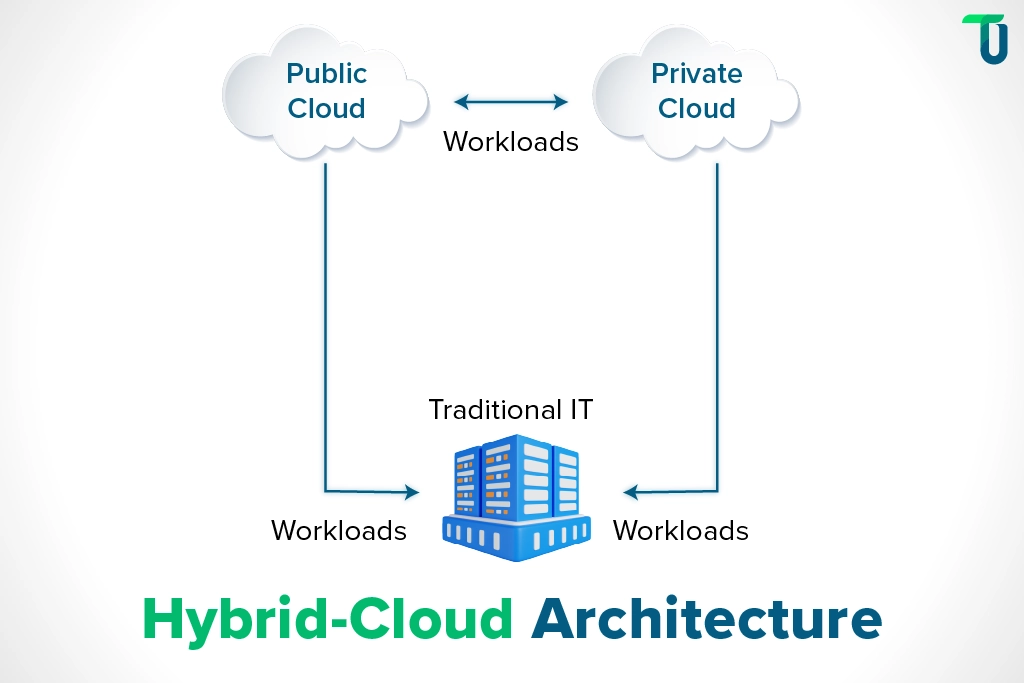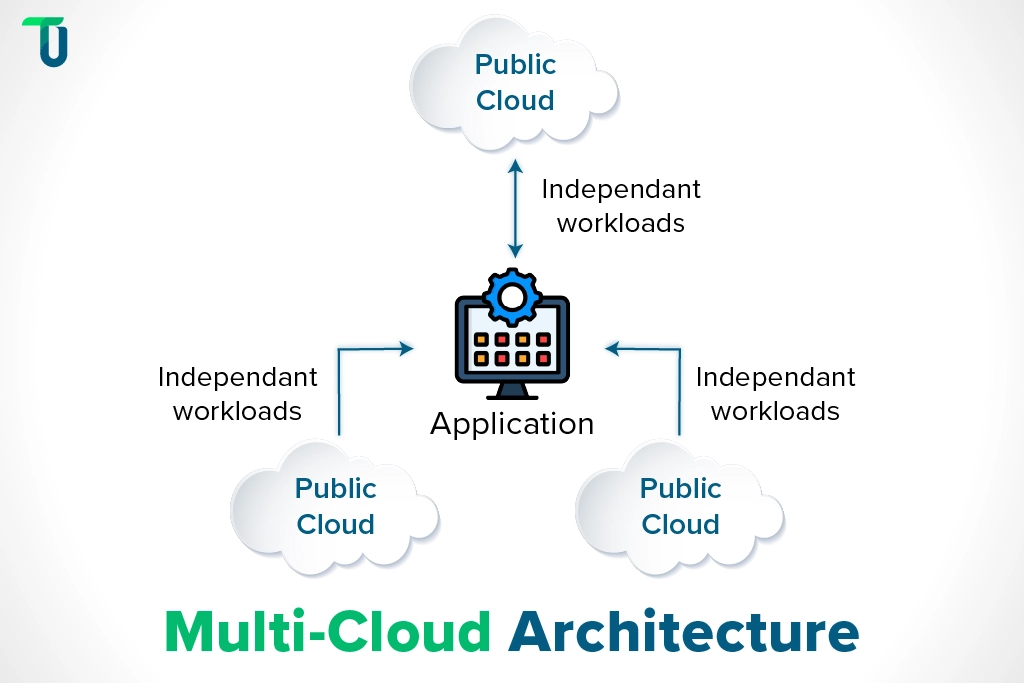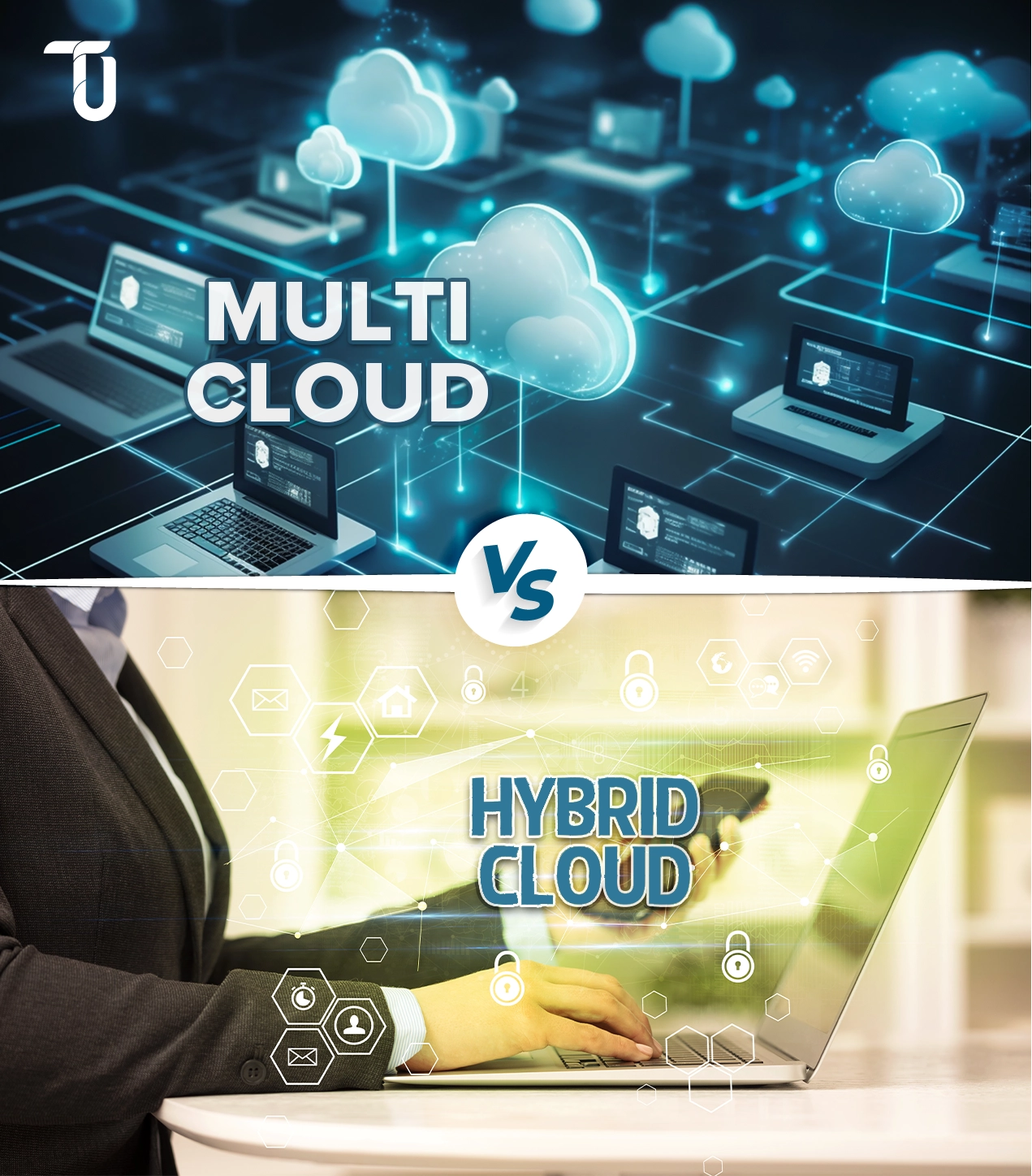Understanding Multi-Cloud and Hybrid Cloud Architectures
Multi-cloud and hybrid cloud are two popular ways companies manage their cloud systems today. Both offer flexibility, better control, and strong performance, but in different ways.
Multi-cloud means using two or more public cloud providers like AWS, Azure, or Google Cloud. Instead of depending on one, companies spread their data across platforms. This adds more flexibility and avoids vendor lock-in.
- Utilize the best services that different cloud providers offer
- Improve backup and reduce the risk of downtime
On the other hand, hybrid cloud mixes on-premises systems or private cloud with public cloud services. This gives more control over sensitive data while also using public cloud benefits. To understand how these two core components differ, explore our detailed guide on public cloud vs private cloud .
- Keep sensitive data on-site for security
- Save costs by using public cloud when needed
Both strategies help balance performance, cost, and compliance.
6 Key Differences Between Multi-Cloud and Hybrid Cloud
For most businesses, choosing between the hybrid and multi-cloud models can be a challenging task, as both offer a range of benefits while also having some downsides. Here are 6 major differences between the hybrid and multi-cloud models.
1. Architecture
Architecture in cloud computing refers to how different systems, services, and platforms are set up and connected. It defines how data moves, where it’s stored, and how applications work across environments.
Hybrid Cloud: Hybrid cloud architecture combines on-premises infrastructure with cloud services. It allows businesses to store sensitive data on-site while utilizing the cloud for scalable services. This balance enables companies to optimize resources and security without fully depending on a single platform.

Multi-Cloud: In multi-cloud architecture, businesses use multiple cloud services from different providers. Each cloud platform operates independently, giving flexibility. This method helps avoid relying on one provider, reducing risks, but it requires more management to ensure smooth interoperability across different clouds.

Also Read: 7 Rs of Cloud Migration: Strategies for Moving Apps to the Cloud
2. Cloud Provider Usage
Cloud provider usage describes how companies select and use services from multiple cloud providers to fulfill particular requirements. It affects flexibility, efficiency and price.
Hybrid Cloud: The hybrid cloud typically uses a primary cloud provider alongside maintaining some workloads on premises. This places just the right trade off between performance - scalability - and security. It is well-suited for companies that need to manage sensitive data on premises while leveraging the cloud for its elasticity and cost savings.
Multi-Cloud: Multi-cloud is about using the cloud services of more than one cloud provider, like AWS, Google Cloud or Azure, for specific areas. This means that companies can choose the best provider for each aspect. When companies don’t have to rely on a single vendor, they lower their risk, foster resilience, and obtain more options for customizing and optimizing.
Did You Know? As of late 2024, AWS leads the market with about 30% global share. Microsoft Azure holds roughly 21% and Google Cloud 12%. Together these top three vendors control around two-thirds of the cloud market. (Source)
3. Integration Level
Integration level refers to how well different cloud services or environments work together. High integration means data flows seamlessly between systems– improving performance and management.
Hybrid Cloud: Hybrid cloud requires strong integration between on-premises infrastructure and cloud services. Businesses need to ensure data and applications move easily between these systems. This level of integration helps manage workloads efficiently, offering control over sensitive data while benefiting from the cloud’s flexibility.
Multi-Cloud: In multi-cloud, integration is often limited. Each cloud operates independently, which means data and services are not always interconnected across platforms. This can create challenges in managing multiple clouds, but it also gives businesses flexibility to choose the best tools from each provider.
Struggling to Choose the Right Cloud Model?
Still unsure whether hybrid or multi-cloud suits your business? Our experts simplify the decision and guide you to the smartest solution.
4. Security and Compliance
Security and compliance focus on protecting data and ensuring businesses follow legal requirements. This is vital for any cloud service, especially when sensitive information is involved.
Hybrid Cloud: Hybrid clouds offer security benefits by letting businesses keep sensitive data on-site, while still using public cloud for scalable workloads. For a deeper dive into the strengths and weaknesses of each environment, see our public cloud vs private cloud comparison . This allows them to apply strict rules and safety measures. However, maintaining strong security across both on-site and cloud settings can be challenging and may require special tools.
Multi-Cloud: Multi-cloud environments add complexity to security and compliance because each cloud provider uses different tools and policies. Businesses must manage security uniformly across all platforms they use. This model helps avoid being tied to one provider, but it demands more work to ensure policies match and data stays protected.
Quick Fact: Gartner predicts 90% of organizations will use a hybrid cloud model by 2027.
5. Deployment Flexibility
“Deployment flexibility” refers to how readily companies can run or move their applications and services across environments. It allows businesses to adapt to changing demands quickly
Hybrid Cloud: It offers a flexible deployment model where organizations are able to run workloads on both on-premise and cloud environments. Organizations can select the right location for security, performance or cost, and change as their needs change. But it does need to be managed to get away cleanly.
Multi-Cloud: Multi-cloud drives deployment flexibility, allowing organizations to consume offerings from various vendors. This flexibility enables companies to choose the best tools for each job, including analytics or hosting. While it does allow for quite a bit of customization, it brings with it complexities when it comes to managing and deploying in a variety of environments.
Related Read: AWS vs Azure vs Google Cloud: Which Is Best for Cloud App Development?.
6. Use Cases
Use cases are specific business cases where cloud models are ideal. They demonstrate how each approach can be applied to solve real-world problems and satisfy a variety of company needs.
Hybrid Cloud: Hybrid cloud is perfect for verticals such as healthcare, finance and government where stigma over data privacy and regulatory oversight must be maintained. It lets companies keep sensitive data on-site, while using the cloud for less sensitive, high-volume work that can benefit from the cloud’s scalability and flexibility.
Multi-Cloud: Multi-cloud is a good fit for organizations that are looking to prevent vendor lock-in, enhance performance, or prevent downtime. It is often used by big enterprises, global organizations and in industry such as e-commerce or media. This architecture allows companies to take advantage of the strengths of both cloud platforms, so they can be stronger.
Hybrid Cloud vs Multi-Cloud: Quick Comparison Table
To help you understand the differences between hybrid-cloud and multi-cloud, here’s a quick comparison table highlighting the key features.
| Feature | Hybrid Cloud | Pre-Built AI Solutions |
|---|---|---|
| Architecture | Combines on-premises and cloud infrastructure. | Uses multiple independent cloud providers. |
| Cloud Provider Usage | Relies mainly on one cloud provider, plus on-prem. | Utilizes multiple providers for different tasks. |
| Integration | Requires strong integration between local and cloud systems. | Limited integration between platforms. |
| Security & Compliance | Easier to manage on-prem data security. | Varies per provider; needs consistent policies. |
| Deployment Flexibility | Limited to the chosen cloud and local systems. | High flexibility with multiple provider choices. |
| Use Cases | Best for industries with strict data privacy needs. | Ideal for avoiding vendor lock-in and optimizing performance. |
As we can see, both hybrid and multi-cloud offer distinct advantages depending on business needs. Choose the one that best aligns with your business requirements, budget, and technical capabilities.
Choosing Between Multi-Cloud and Hybrid Cloud: What’s Best for Your Business?
Deciding between multi-cloud architecture and hybrid cloud depends on your business needs, goals, and resources. Here’s a quick breakdown to help you choose:
Hybrid Cloud is best if you need:
- Control over sensitive data with on-premises storage.
- Easy integration between your local systems and the cloud.
- A balance of security and flexibility.
Multi-Cloud is ideal if you need:
- Freedom to select the best provider for each service.
- A solution to avoid vendor lock-in.
- Increased flexibility with services from multiple providers.
Above all, choose the model that aligns with your company’s requirements, budget, and technical capabilities. Still confused? Consider consulting a cloud solution architect.
Choose the Right Cloud Architecture for Your Business
Multi-cloud and hybrid cloud architectures each bring distinct benefits to the table. Choosing between them depends on your business objectives, security needs, and technical capabilities. If your organization values flexibility, reduced vendor lock-in, and optimized performance, a multi-cloud approach might be ideal.
Not sure which cloud strategy fits your business best? TenUp Software Services is here to help. Our experienced team offers customized solutions to align your cloud infrastructure with your long-term goals. Check out our cloud services and see how we can assist you at TenUp.
Find Your Perfect Cloud Strategy with TenUp Today
From multi-cloud agility to hybrid control, we help tailor the right cloud mix for your needs. Talk to us and future-proof your infrastructure today.
Frequently asked questions
What is the main difference between multi-cloud and hybrid cloud?
Hybrid cloud combines on-premises or private infrastructure with public cloud services for better control and scalability.
Multi-cloud uses services from multiple public or private cloud providers to increase flexibility, avoid vendor lock-in, and optimize performance.
Key difference: Hybrid cloud blends private and public environments, while multi-cloud mixes multiple providers—often all public—for specialized workloads. However, sometimes multi-cloud setups mix public and private environments.
How do I decide which cloud strategy is right for my business?
Start with your business priorities—control, cost, flexibility, security, and scalability.
Choose hybrid cloud if you need to balance data control with cloud scalability.
Choose multi-cloud if you want vendor flexibility, performance optimization, or to avoid lock-in.
How does vendor lock-in differ between hybrid and multi-cloud strategies?
Multi-cloud minimizes vendor lock-in by distributing workloads across multiple providers, allowing flexibility, easier migration, and the ability to choose best-fit services.
Hybrid cloud, while combining on-premises and cloud, often relies on a single vendor’s tools or APIs—making it more prone to lock-in unless mitigated through open standards and portable architectures.
Can hybrid cloud models support real-time data processing effectively?
Yes. Hybrid cloud supports real-time processing by keeping latency-sensitive workloads on-premises for speed, while offloading scalable tasks to the cloud. This ensures low latency, high performance, and flexibility, provided data integration and synchronization are seamless.
How do disaster recovery strategies differ between hybrid and multi-cloud environments?
Hybrid cloud uses on-premises and cloud resources for backup, offering control but requiring tight integration. Multi-cloud spreads workloads across providers, enhancing resilience and avoiding single points of failure—ideal for high availability.
What are the challenges in managing compliance across multi-cloud platforms?
Managing compliance in multi-cloud environments is complex due to inconsistent policies, tools, and regulations across providers. Key challenges include lack of centralized visibility, fragmented identity and access controls, data sovereignty issues, and differing audit requirements. Standardizing policies and using automated compliance tools across clouds is essential to stay secure and audit-ready.
Is it feasible to transition from a hybrid cloud to a multi-cloud architecture?
Yes, transitioning from hybrid to multi-cloud is feasible and increasingly common. It enables greater flexibility, cost control, and vendor diversification. However, success depends on planning for interoperability, data migration, and unified security across providers.

